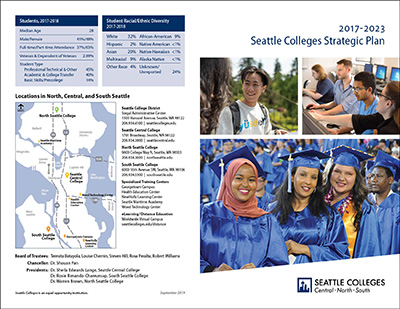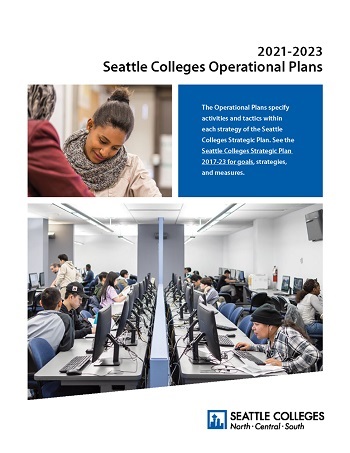Strategic Planning 2017-2023
Strategic and Operational Plans

2017-23 Strategic Plan – District

2021-23 Operational Plans - Seattle Colleges
Scorecard
- 2023 Update of the Strategic Plan Scorecard (November 2023)
- 2022 Update of the Strategic Plan Scorecard

The Seattle Colleges Strategic Plan 2017–23 provided broad, forward-looking direction to ensure student success in the dynamic and vibrant city of Seattle.
The board of trustees—in consultation with the district community, including faculty, staff, students, administrative leadership, and external partners—initiated and approved the new strategic plan.
The plan reflected a common purpose, beliefs, commitments, and priorities. It also established a set of major goals that would be achieved over time at each college and across the district. The strategic plan recognized the unique characteristics of each of the colleges and included a range of high-level strategies that were operationalized in a manner appropriate for each college. Ultimately, the strategic plan acknowledged our proud history, short-term challenges, and opportunities while identifying future directions, aspirations, and operational strategies. It also affirmed our fundamental mission: to prepare each student for a successful life and work in a diverse, global, and dynamic society.
Overview of the Strategic Planning Process 2016-17
The previous 2010-17 Seattle Colleges strategic plan sunsetted in 2017. With this in mind, the board of trustees initiated a process to develop a new districtwide strategic plan in late 2016. The new plan serves to set strategic direction for Seattle Colleges for future years. The colleges will develop operational plans in support of the districtwide strategic plan. A critical part of the strategic planning process was to engage and gain input from our stakeholders, including our employees.
Strategic Planning Phases 2016-17
The district planned a series of conversations beginning in the Winter Quarter of 2017. Additional conversations continued throughout the subsequent months to ensure faculty, staff, students, community members, and civic and business leaders were able to provide feedback. Our goal was to seek input from valued community members to chart a path for our future.
In addition to strategic planning, the chancellor and college leadership carried out other related major initiatives: Budget Planning and Achieving System Integration.

Timeline and Milestones 2016-17
The strategic plan built upon the planning that already took place at each of the colleges and aligned common goals and purposes as well as approaches to our work. Members of the board of trustees, the chancellor and vice chancellors, and presidents agreed that working toward one mission, vision, values, and set of common goals for the entire district is the long-term goal. The board of trustees in consultation with stakeholders is ultimately accountable for setting the mission and goals of Seattle Colleges.

Gathering Input
Through June of 2017, input was received from members of the chancellor’s advisory council; the district management team; more than 20 external experts from business, government, and community; and nearly 200 employees through an online survey. Additional input activities included a town hall and stakeholder input meetings with faculty and classified staff.

Stakeholder Input Meetings—Spring 2017
| May 8 | Town Hall Meeting | Central, North, and South |
| May 9 | Faculty Input | Central |
| May 10 | Classified Input | Central |
| May 15 | Classified Input | South |
| May 22 | Faculty Input | South |
| May 30 | Classified Input | North |
| May 30 | Faculty Input | North |

Final Steps
In the fall of 2018, the chancellor’s executive cabinet and college leadership teams finalized measures, strategies, and operational plans. Across the strategic plan’s four goal areas, a common set of twelve districtwide measures have been identified. These measures enable comparisons across the colleges and over time. Also, seven districtwide strategies provide broad, forward-looking guidance to advance goals and respective measures. The finalized strategic plan is supported by a dynamic, interactive scorecard. Periodic in-depth reviews of each goal area and measures are held at meetings of the board of trustees.
